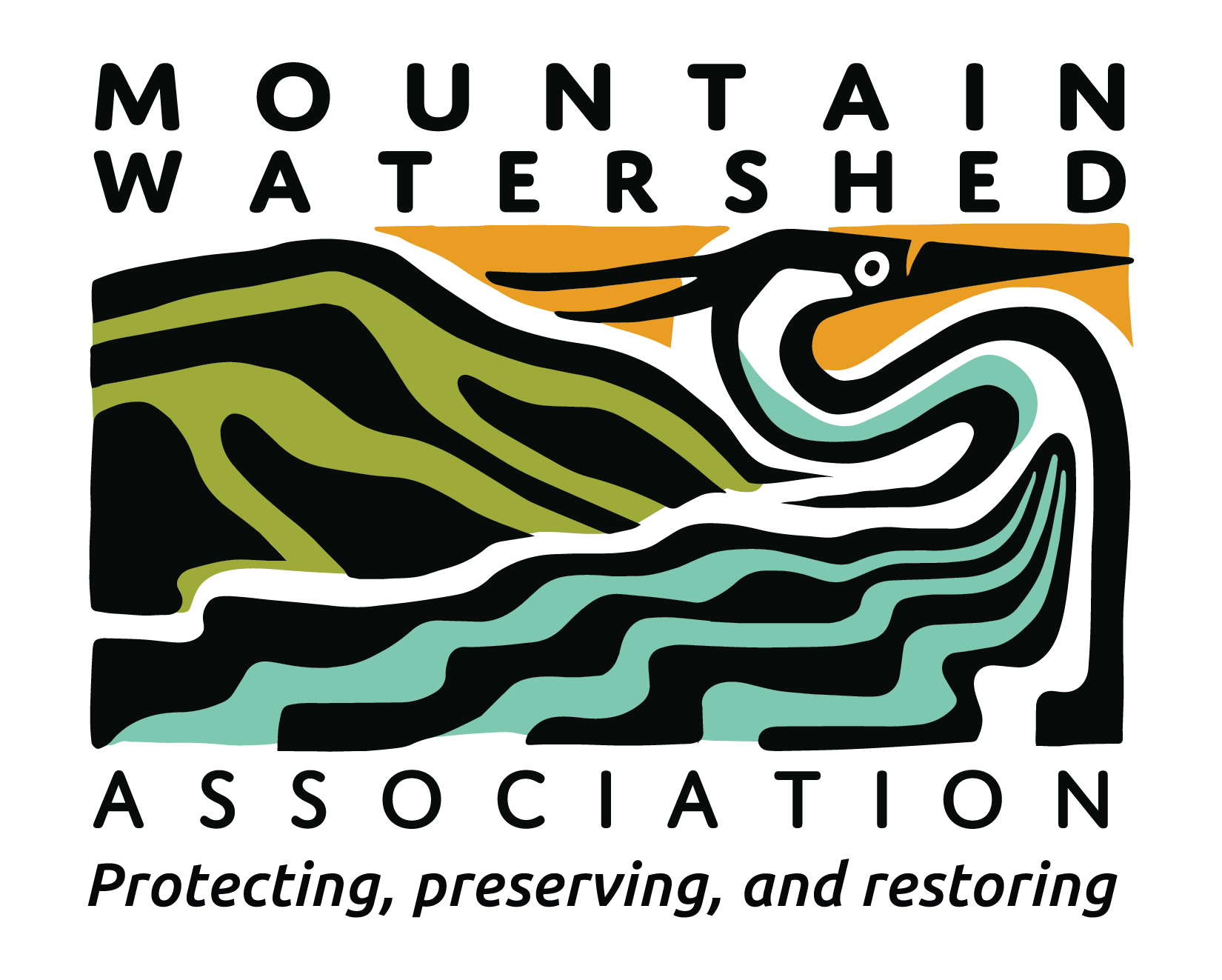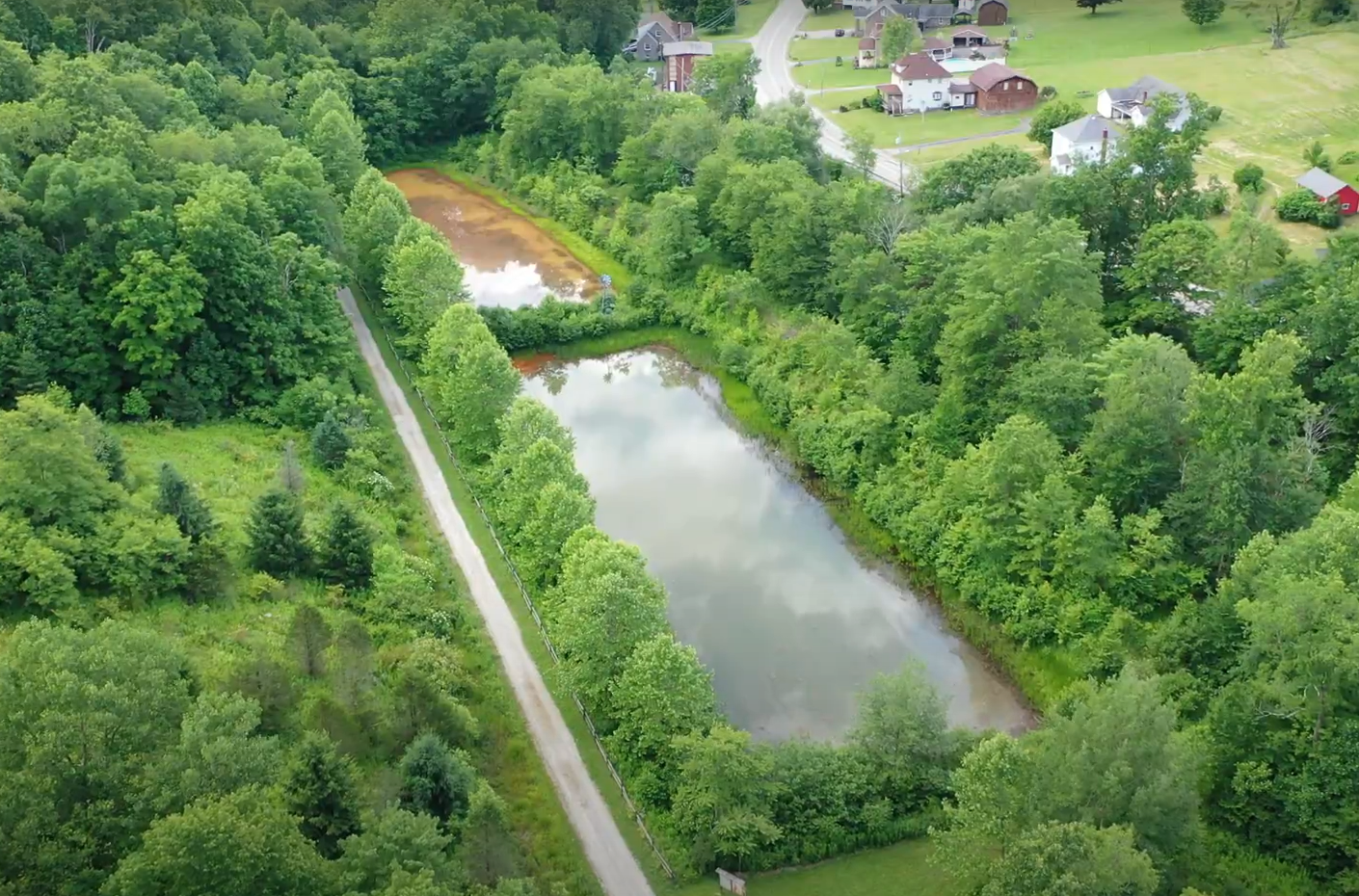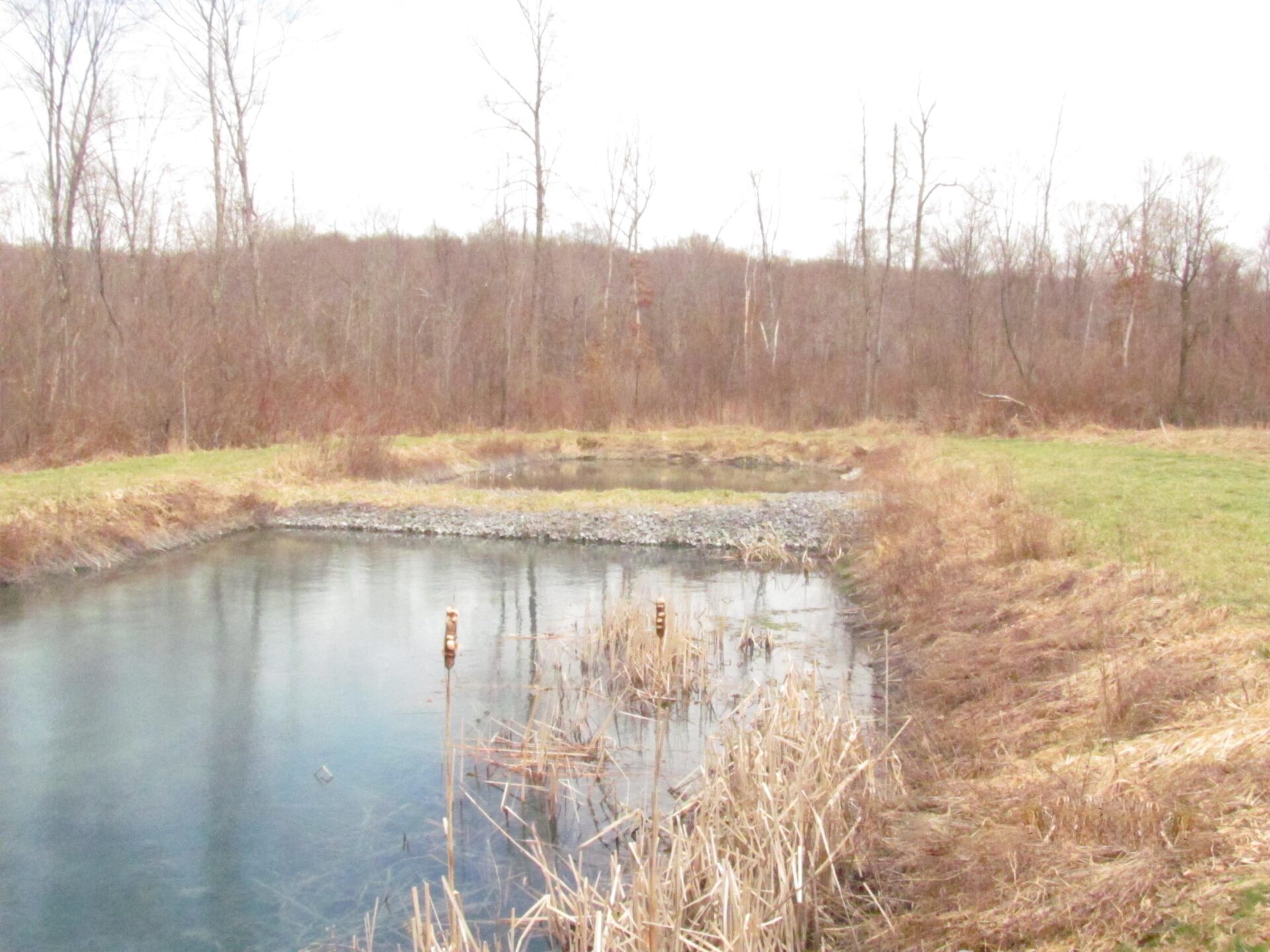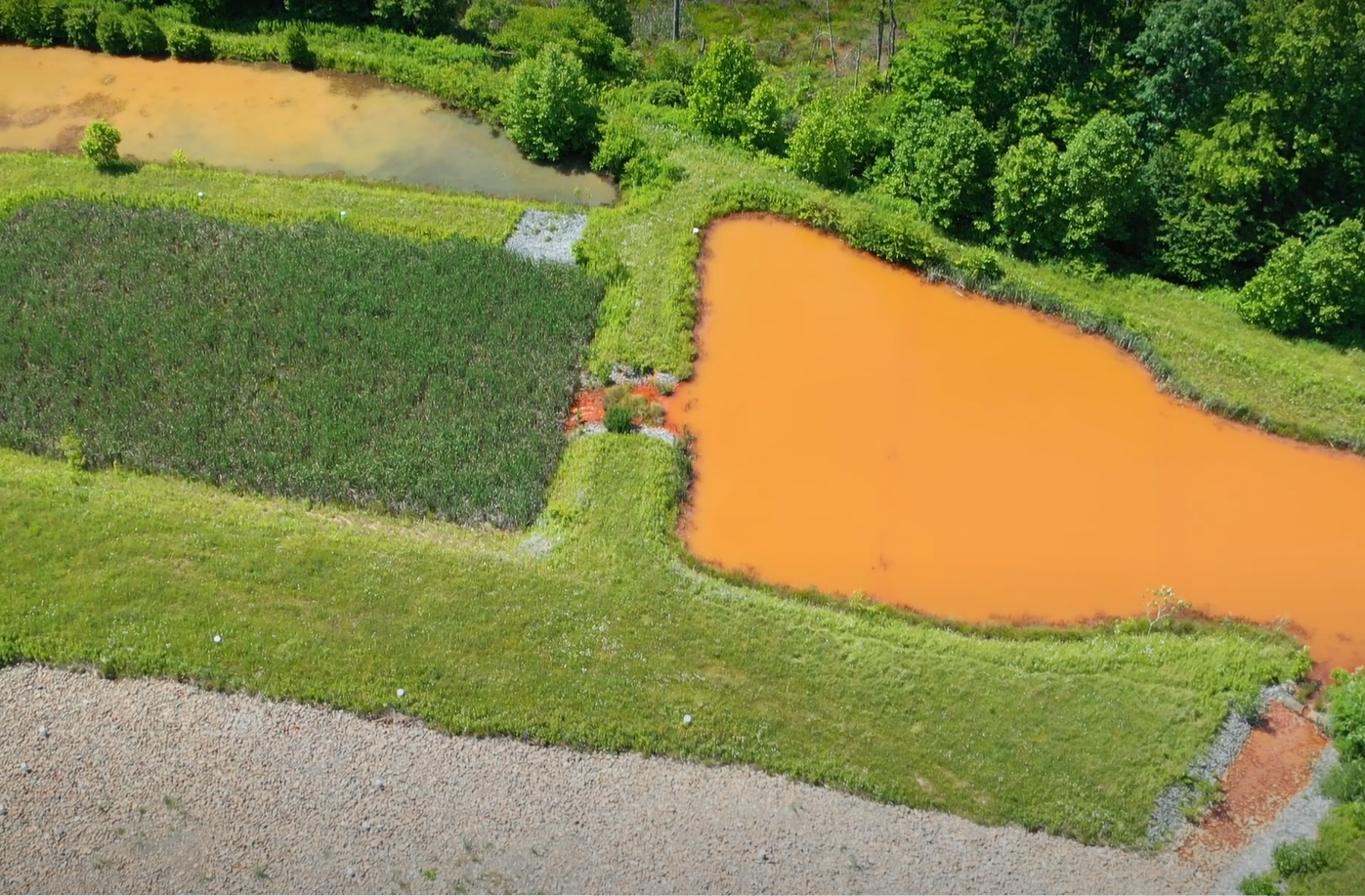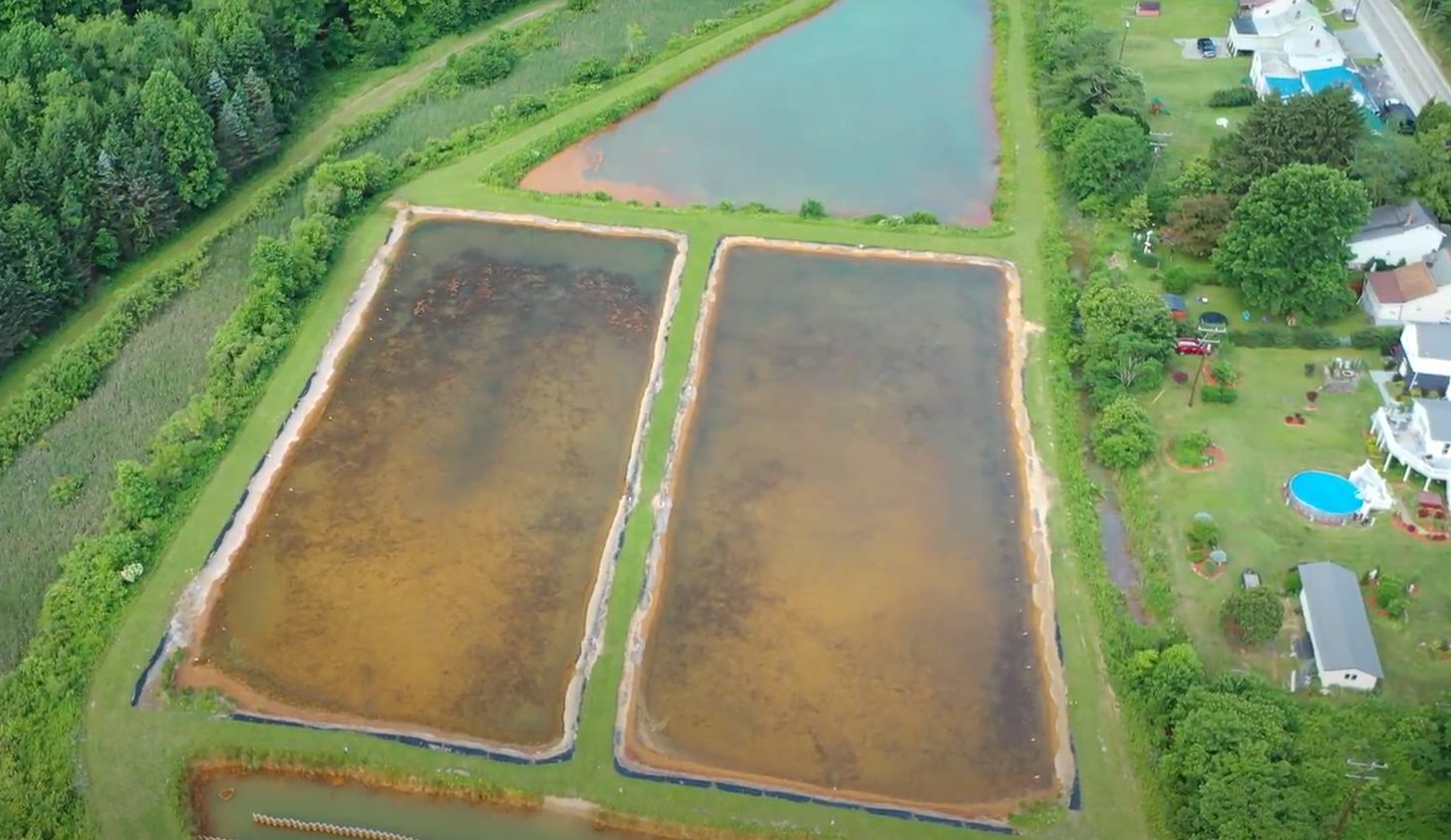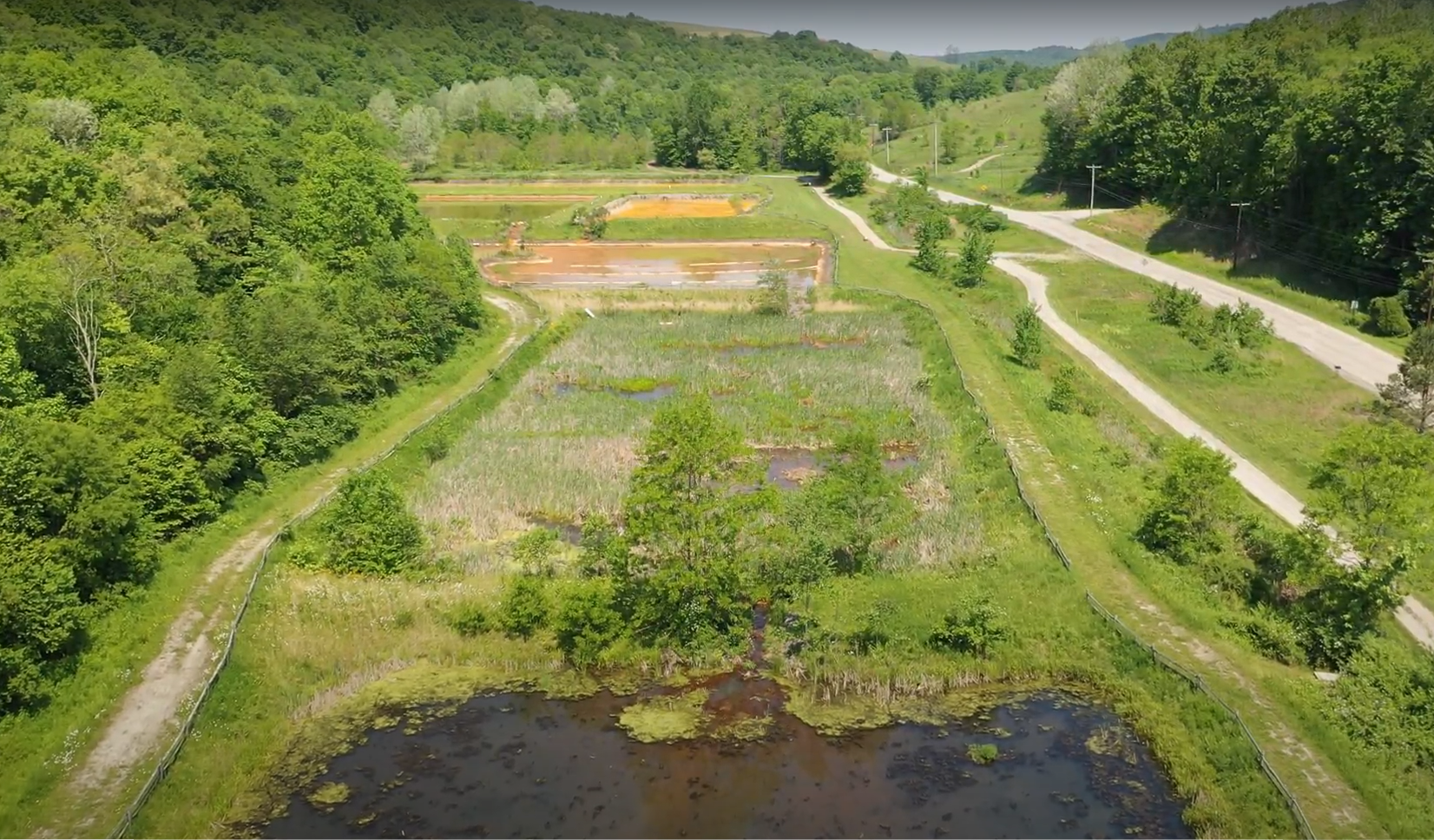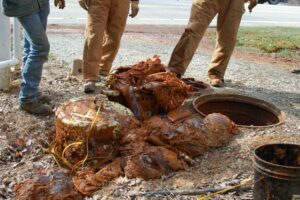Remediation
Since the organization began in 1994, Mountain Watershed Association has restored 70% of Indian Creek, reducing the length of impaired stream miles in the watershed from 47 miles to 14. The first abandoned mine discharge treatment system was developed in the Indian Creek watershed in 2001. Since then, we have developed 5 treatment systems to divert contaminated mine water, filter out pollutants, and direct the cleaned water back into the stream.
A Brief Explanation of Abandoned Mine Drainage (AMD)
Coal extraction from both surface and deep mines exposes rock layers that contain minerals, such as iron, aluminum, and manganese. When these minerals are exposed to water and air, they can become dissolved in water and create a chemical reaction, sometimes coloring the water red (iron), white (aluminum), or have no effect on the water clarity and color.
This metal-rich water can flow from runoff on surface mines and seeps from abandoned underground mines that fill with water over time. The Indian Creek watershed is impacted by dozens of abandoned underground coal mines that leach contaminated water from the mine pool into the mainstem and tributary streams of Indian Creek. We typically refer to this as abandoned mine drainage, or AMD. If left untreated, chronic pollution from AMD will impair or kill much of the aquatic life within streams.
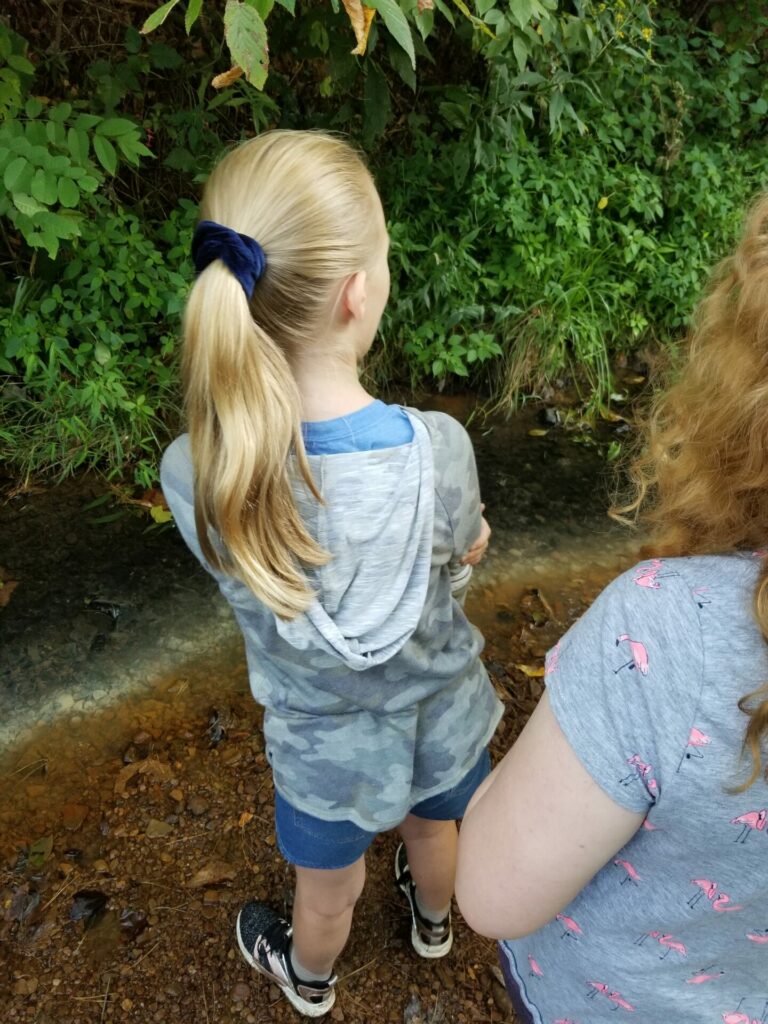
Our Abandoned Mine Discharge Projects
Abandoned coal mines, some taken out of commission over 100 years ago, are a major source of pollution impacting stream health in the Indian Creek watershed. MWA has developed a number of projects to implement treatment systems that remediate areas impacted by abandoned mine discharges. Click on the pictures to learn more about each remediation project.
Also known as Sagamore, this project is named after the now-deceased owner of the land where the project is located. This project was the first undertaken by MWA. The system consists of the collection of two underground mine discharges from the abandoned Sagamore Coal Company’s Big Chief Mine and the relocation and reclamation of a 70,000 cubic yard gob pile. This system also includes two windmills, designed to add oxygen to the water in order to cause the iron to drop out faster. The treatment system now removes about 87% of the iron load, 70% of the aluminum load, and 61% of the acid load.
You can see the ponds, windmills, and discharge of the Sagamore treatment system pictured above when walking on the trail. AMD from the Big Chief mine is treated here by exposing it to limestone and oxygen. The limestone is slowly dissolved by the acidic water, raising its pH to a level closer to drinking water. Raising the pH allows the dissolved metals (mainly iron and aluminum) to oxidize to solid particles and settle at the bottom of the ponds. After the system has done its work, the treated AMD then flows into Indian Creek.
This is a passive method of AMD treatment therefore the system does not require much technology or oversight, but it does require regular maintenance to keep it working correctly.
The Sagamore Treatment System was the first system built by Mountain Watershed Association and about a month before the system was built, the chemistry of the discharge changed alarmingly. Since then, a rogue mine drainage discharge has surfaced very close to Sagamore, releasing iron-rich water into Indian Creek beside the Sagamore treatment system.
The Sagamore treatment system treats two underground mine discharges from the Sagamore Coal Company’s Big Chief Mine. Based on the location of the discharge and the location of the Indian Creek Valley Trail the only suitable location for a treatment system was that of a 70,000 cubic yard refuse pile along the banks of Indian Creek. Thus, the relocation and reclamation of this refuse pile was incorporated into the project.
The system was designed to treat two mine discharges, one highly acidic and iron-laden and the other alkaline, but also containing high iron concentrations. Both discharges were piped into the first pond where they mixed and began to neutralize and treat each other. Windmill aerators were also installed to increase oxygen levels assisting in the iron and acid removal of the treatment process. By the time the water left the first basin the pH ranged from 6.2 to 6.8. In the second settling basin the water was given additional time for the iron to precipitate out of solution before it discharged back into Indian Creek with a pH between 6.5 to 6.9.
Due to the last minute chemistry change an anoxic limestone drain was installed to catch the acidic discharge and try to reduce the increase in acidity, iron concentration, and aluminum. Although the exact reason for the change is unknown it is probable that a subsidence event occurred in the underground mine exposing pyretic material to the discharge.
This change in chemistry may be more important than originally speculated as we periodically have flushes of a high aluminum discharge that seeps out of the ground and discharges into Indian Creek completely avoiding the treatment system. This altered discharge seeps out along the Indian Creek Valley Trail and travels along the drainage ditch before diverting under the trail and following the old discharge channel to Indian Creek. Capturing this discharge and adding it to the system would only harm the treatment system as the system was not built to address the high concentrations of aluminum this new discharge contains. Mountain Watershed Association is working with the Bureau of Abandoned Mine Drainage to identify and understand this discharge so that we can establish a treatment option for this discharge without harming the existing treatment system.
Water samples at the site have been collected for over 20 years and are instrumental in treatment design options.
Built in 2001 the installation of the Sagamore Treatment System cost $358,000.
It is also estimated that MWA spends $12,200 annually on monitoring and maintenance tasks at the Sagamore Treatment System
Funding for construction and maintenance provided by:
- Natural Resources Conservation Service
- Environmental Protection Agency—319 Funds
- PA Department of Environmental Protection
- Foundation for PA Watersheds
- Richard King Mellon Foundation
- Colcom Foundation
- Anna & Joseph Gartner Foundation
- McKenna Foundation
- Baltimore Life Company
- Community Foundation of Fayette County
- Eberly Foundation
- Allegheny Power
- Alice Meadows
- Max B. Nobel Family
Mountain Watershed Association (MWA) is responsible for operation and maintenance of this system. Monitoring and maintenance of passive treatment system are important steps often overlooked and their cost underestimated.
In 2013, with funding provided through the Growing Greener program MWA completed an Operation, Maintenance, & Replacement Plan for all of its project sites, including Sagamore. This document outlines the routine practices needed to keep the system working at optimal levels.
Maintenance Tasks include:
- Annual Catch Basin Pipe Cleaning
- Vegetation Control
Monitoring Tasks include:
- Quarterly water samples
- Flow monitoring
- Bi-annual macroinvertebrate surveys
- Quarterly Site Inspections
Effluent return into Indian Creek has returned to a neutral 7 pH.
Also known as Sagamore, this project is named after the now-deceased owner of the land where the project is located. This project was the first undertaken by MWA. The system consists of the collection of two underground mine discharges from the abandoned Sagamore Coal Company’s Big Chief Mine and the relocation and reclamation of a 70,000 cubic yard gob pile. This system also includes two windmills, designed to add oxygen to the water in order to cause the iron to drop out faster. The treatment system now removes about 87% of the iron load, 70% of the aluminum load, and 61% of the acid load.
You can see the ponds, windmills, and discharge of the Sagamore treatment system pictured above when walking on the trail. AMD from the Big Chief mine is treated here by exposing it to limestone and oxygen. The limestone is slowly dissolved by the acidic water, raising its pH to a level closer to drinking water. Raising the pH allows the dissolved metals (mainly iron and aluminum) to oxidize to solid particles and settle at the bottom of the ponds. After the system has done its work, the treated AMD then flows into Indian Creek.
This is a passive method of AMD treatment therefore the system does not require much technology or oversight, but it does require regular maintenance to keep it working correctly.
The Sagamore Treatment System was the first system built by Mountain Watershed Association and about a month before the system was built, the chemistry of the discharge changed alarmingly. Since then, a rogue mine drainage discharge has surfaced very close to Sagamore, releasing iron-rich water into Indian Creek beside the Sagamore treatment system.
The Sagamore treatment system treats two underground mine discharges from the Sagamore Coal Company’s Big Chief Mine. Based on the location of the discharge and the location of the Indian Creek Valley Trail the only suitable location for a treatment system was that of a 70,000 cubic yard refuse pile along the banks of Indian Creek. Thus, the relocation and reclamation of this refuse pile was incorporated into the project.
The system was designed to treat two mine discharges, one highly acidic and iron-laden and the other alkaline, but also containing high iron concentrations. Both discharges were piped into the first pond where they mixed and began to neutralize and treat each other. Windmill aerators were also installed to increase oxygen levels assisting in the iron and acid removal of the treatment process. By the time the water left the first basin the pH ranged from 6.2 to 6.8. In the second settling basin the water was given additional time for the iron to precipitate out of solution before it discharged back into Indian Creek with a pH between 6.5 to 6.9.
Due to the last minute chemistry change an anoxic limestone drain was installed to catch the acidic discharge and try to reduce the increase in acidity, iron concentration, and aluminum. Although the exact reason for the change is unknown it is probable that a subsidence event occurred in the underground mine exposing pyretic material to the discharge.
This change in chemistry may be more important than originally speculated as we periodically have flushes of a high aluminum discharge that seeps out of the ground and discharges into Indian Creek completely avoiding the treatment system. This altered discharge seeps out along the Indian Creek Valley Trail and travels along the drainage ditch before diverting under the trail and following the old discharge channel to Indian Creek. Capturing this discharge and adding it to the system would only harm the treatment system as the system was not built to address the high concentrations of aluminum this new discharge contains. Mountain Watershed Association is working with the Bureau of Abandoned Mine Drainage to identify and understand this discharge so that we can establish a treatment option for this discharge without harming the existing treatment system.
Water samples at the site have been collected for over 20 years and are instrumental in treatment design options.
Built in 2001 the installation of the Sagamore Treatment System cost $358,000.
It is also estimated that MWA spends $12,200 annually on monitoring and maintenance tasks at the Sagamore Treatment System
Funding for construction and maintenance provided by:
- Natural Resources Conservation Service
- Environmental Protection Agency—319 Funds
- PA Department of Environmental Protection
- Foundation for PA Watersheds
- Richard King Mellon Foundation
- Colcom Foundation
- Anna & Joseph Gartner Foundation
- McKenna Foundation
- Baltimore Life Company
- Community Foundation of Fayette County
- Eberly Foundation
- Allegheny Power
- Alice Meadows
- Max B. Nobel Family
Mountain Watershed Association (MWA) is responsible for operation and maintenance of this system. Monitoring and maintenance of passive treatment system are important steps often overlooked and their cost underestimated.
In 2013, with funding provided through the Growing Greener program MWA completed an Operation, Maintenance, & Replacement Plan for all of its project sites, including Sagamore. This document outlines the routine practices needed to keep the system working at optimal levels.
Maintenance Tasks include:
- Annual Catch Basin Pipe Cleaning
- Vegetation Control
Monitoring Tasks include:
- Quarterly water samples
- Flow monitoring
- Bi-annual macroinvertebrate surveys
- Quarterly Site Inspections
Effluent return into Indian Creek has returned to a neutral 7 pH.
The Permapress treatment system was named from its unique chemical property, a lack of iron. Therefore, the system was named after the chemical process in which fabrics are permanently treated for wrinkle resistance so that no ironing is needed, thus permapress.
Before the construction of the system 20 gallons per a minute of mine drainage spewed from the site into an unnamed tributary to Indian Creek.
The discharge contained 150 mg/L of acid, 23 mg/L of aluminum, but less than 1 mg/L of iron.
The Permapress treatment system is a low hazard mine drainage treatment system. It is considered low hazard because surface water does not enter the treatment system. The discharge is coming from a reclaimed strip mine near Normalville, PA.
The treatment system consists of a limestone treatment bed. That is used to increase the pH and provides the aluminum 1.34 days to fall out of solution. To avoid clogging, a bell siphon is used to flush the bed every 32 hours at a maximum flow rate of 35 gallons per minute. The flushed water is transported to an earth filled settling basin. At the settling basin aluminum continues to precipitate out of solution allowing the clean water to slowly discharge through a small wetland to an unnamed tributary of Indian Creek.
The system was designed to treat two mine discharges, one highly acidic and iron-laden and the other alkaline, but also containing high iron concentrations. Both discharges were piped into the first pond where they mixed and began to neutralize and treat each other. Windmill aerators were also installed to increase oxygen levels assisting in the iron and acid removal of the treatment process. By the time the water left the first basin the pH ranged from 6.2 to 6.8. In the second settling basin the water was given additional time for the iron to precipitate out of solution before it discharged back into Indian Creek with a pH between 6.5 to 6.9.
Due to the last minute chemistry change an anoxic limestone drain was installed to catch the acidic discharge and try to reduce the increase in acidity, iron concentration, and aluminum. Although the exact reason for the change is unknown it is probable that a subsidence event occurred in the underground mine exposing pyretic material to the discharge.
This change in chemistry may be more important than originally speculated as we periodically have flushes of a high aluminum discharge that seeps out of the ground and discharges into Indian Creek completely avoiding the treatment system. This altered discharge seeps out along the Indian Creek Valley Trail and travels along the drainage ditch before diverting under the trail and following the old discharge channel to Indian Creek. Capturing this discharge and adding it to the system would only harm the treatment system as the system was not built to address the high concentrations of aluminum this new discharge contains. Mountain Watershed Association is working with the Bureau of Abandoned Mine Drainage to identify and understand this discharge so that we can establish a treatment option for this discharge without harming the existing treatment system.
Water samples at the site have been collected for over 20 years and are instrumental in treatment design options.
Installation of the Permapress treatment system cost approximately $170,000. It was designed and built by
USDA Department of Natural Resources and Conservation Services.
Funding for construction and maintenance provided by:
- Natural Resources Conservation Service
- Office of Surface Mining
- Foundation for Pennsylvania Watersheds
- Pennsylvania Department of Environmental
- Colcom Foundation
- Richard King Mellon Foundation
Mountain Watershed Association (MWA) is responsible for operation and maintenance of this system. monitoring and maintenance of passive treatment systems are important steps often overlooked and their cost underestimated.
In 2013, through funding provided through the Growing Greener program MWA completed an Operation, Maintenance, & Replacement Plan for all of its project sites, including Permapress. This document outlines the routine practices needed to keep the system working at optimal levels.
Maintenance Tasks include:
♦ Bell siphon cleaning
♦ Vegetation Control
Monitoring Tasks include:
♦ Quarterly water samples
♦ Quarterly Site Inspections
The Permapress treatment system was named from its unique chemical property, a lack of iron. Therefore, the system was named after the chemical process in which fabrics are permanently treated for wrinkle resistance so that no ironing is needed, thus permapress.
Before the construction of the system 20 gallons per a minute of mine drainage spewed from the site into an unnamed tributary to Indian Creek.
The discharge contained 150 mg/L of acid, 23 mg/L of aluminum, but less than 1 mg/L of iron.
The Permapress treatment system is a low hazard mine drainage treatment system. It is considered low hazard because surface water does not enter the treatment system. The discharge is coming from a reclaimed strip mine near Normalville, PA.
The treatment system consists of a limestone treatment bed. That is used to increase the pH and provides the aluminum 1.34 days to fall out of solution. To avoid clogging, a bell siphon is used to flush the bed every 32 hours at a maximum flow rate of 35 gallons per minute. The flushed water is transported to an earth filled settling basin. At the settling basin aluminum continues to precipitate out of solution allowing the clean water to slowly discharge through a small wetland to an unnamed tributary of Indian Creek.
The system was designed to treat two mine discharges, one highly acidic and iron-laden and the other alkaline, but also containing high iron concentrations. Both discharges were piped into the first pond where they mixed and began to neutralize and treat each other. Windmill aerators were also installed to increase oxygen levels assisting in the iron and acid removal of the treatment process. By the time the water left the first basin the pH ranged from 6.2 to 6.8. In the second settling basin the water was given additional time for the iron to precipitate out of solution before it discharged back into Indian Creek with a pH between 6.5 to 6.9.
Due to the last minute chemistry change an anoxic limestone drain was installed to catch the acidic discharge and try to reduce the increase in acidity, iron concentration, and aluminum. Although the exact reason for the change is unknown it is probable that a subsidence event occurred in the underground mine exposing pyretic material to the discharge.
This change in chemistry may be more important than originally speculated as we periodically have flushes of a high aluminum discharge that seeps out of the ground and discharges into Indian Creek completely avoiding the treatment system. This altered discharge seeps out along the Indian Creek Valley Trail and travels along the drainage ditch before diverting under the trail and following the old discharge channel to Indian Creek. Capturing this discharge and adding it to the system would only harm the treatment system as the system was not built to address the high concentrations of aluminum this new discharge contains. Mountain Watershed Association is working with the Bureau of Abandoned Mine Drainage to identify and understand this discharge so that we can establish a treatment option for this discharge without harming the existing treatment system.
Water samples at the site have been collected for over 20 years and are instrumental in treatment design options.
Installation of the Permapress treatment system cost approximately $170,000. It was designed and built by
USDA Department of Natural Resources and Conservation Services.
Funding for construction and maintenance provided by:
- Natural Resources Conservation Service
- Office of Surface Mining
- Foundation for Pennsylvania Watersheds
- Pennsylvania Department of Environmental
- Colcom Foundation
- Richard King Mellon Foundation
Mountain Watershed Association (MWA) is responsible for operation and maintenance of this system. monitoring and maintenance of passive treatment systems are important steps often overlooked and their cost underestimated.
In 2013, through funding provided through the Growing Greener program MWA completed an Operation, Maintenance, & Replacement Plan for all of its project sites, including Permapress. This document outlines the routine practices needed to keep the system working at optimal levels.
Maintenance Tasks include:
♦ Bell siphon cleaning
♦ Vegetation Control
Monitoring Tasks include:
♦ Quarterly water samples
♦ Quarterly Site Inspections
The Gallentine Treatment system was designed three times, and built twice to provide the effective treatment system we have at the site today.
Before construction of the Gallentine Treatment System could begin the design was modified and the treatment site was relocated from its originally proposed location in order to adhere to wetland permitting issues. The change in design required the mine pool elevation to be raised to attain adequate area for treatment. However, this altered design was unsuccessful, the clogging of the anoxic limestone drain and consistent elevation changes led to a blowout upstream. In 2008 the system was redesigned and reconstructed at the same location requiring additional funding to be spent.
The discharge enters the reconstructed system via perforated pipes beneath a bed of limestone in the vertical
up-flow bed in order to increase alkalinity. The iron is preserved in the ferrous form and prevented from
contacting oxygen so that it doesn’t coat the limestone making it unreactive or clog the system. From there it flows through the flume into the first settling pond where the metals begin to precipitate out as it passes
through limestone baffles which again increase alkalinity. The discharge then enters the vertical down flow pond where it flows through compost into another limestone bed before discharging into a second settling pond.
Additional metals deposit into the settling basin before it outlets through the natural wetlands and into Indian Creek upstream of Poplar Run.
The Gallentine discharge flowed between 18-199 gallons per minute from a hazardous mine portal into Indian Creek. Without treatment 124- 195 mg/L of acid, 74 mg/L of iron, and 7-11 mg/L or Aluminum would be discharged into Indian Creek.
In 2003, construction of the Gallentine treatment system cost $180,000. In 2008, the system was redesigned and rebuilt at an additional cost of $854,793.
Funding for construction and maintenance provided by:
♦ Natural Resources Conservation Service
♦ Office of Surface Mining
♦ PA Department of Environmental Protection
♦ Municipal Authority of Westmoreland County
♦ Richard King Mellon Foundation
♦ Colcom Foundation
♦ Foundation for PA Watersheds
Mountain Watershed Association (MWA) is responsible for operation and maintenance of this system. Monitoring and maintenance of passive treatment systems are important steps often overlooked and their cost underestimated.
In 2013, with funding provided through the Growing Greener program MWA completed an Operation, Maintenance, & Replacement Plan for all of its project sites, including Gallentine. This document outlines the routine practices needed to keep the system working at optimal levels.
Maintenance Tasks include:
♦ Bi-monthly Flushing
♦ Annual Pipe Cleanings
♦ Vegetation Control
Monitoring Tasks include:
♦ Quarterly water samples
♦ Bi-annual macroinvertebrate surveys
The Gallentine Treatment system was designed three times, and built twice to provide the effective treatment system we have at the site today.
Before construction of the Gallentine Treatment System could begin the design was modified and the treatment site was relocated from its originally proposed location in order to adhere to wetland permitting issues. The change in design required the mine pool elevation to be raised to attain adequate area for treatment. However, this altered design was unsuccessful, the clogging of the anoxic limestone drain and consistent elevation changes led to a blowout upstream. In 2008 the system was redesigned and reconstructed at the same location requiring additional funding to be spent.
The discharge enters the reconstructed system via perforated pipes beneath a bed of limestone in the vertical
up-flow bed in order to increase alkalinity. The iron is preserved in the ferrous form and prevented from
contacting oxygen so that it doesn’t coat the limestone making it unreactive or clog the system. From there it flows through the flume into the first settling pond where the metals begin to precipitate out as it passes
through limestone baffles which again increase alkalinity. The discharge then enters the vertical down flow pond where it flows through compost into another limestone bed before discharging into a second settling pond.
Additional metals deposit into the settling basin before it outlets through the natural wetlands and into Indian Creek upstream of Poplar Run.
The Gallentine discharge flowed between 18-199 gallons per minute from a hazardous mine portal into Indian Creek. Without treatment 124- 195 mg/L of acid, 74 mg/L of iron, and 7-11 mg/L or Aluminum would be discharged into Indian Creek.
In 2003, construction of the Gallentine treatment system cost $180,000. In 2008, the system was redesigned and rebuilt at an additional cost of $854,793.
Funding for construction and maintenance provided by:
♦ Natural Resources Conservation Service
♦ Office of Surface Mining
♦ PA Department of Environmental Protection
♦ Municipal Authority of Westmoreland County
♦ Richard King Mellon Foundation
♦ Colcom Foundation
♦ Foundation for PA Watersheds
Mountain Watershed Association (MWA) is responsible for operation and maintenance of this system. Monitoring and maintenance of passive treatment systems are important steps often overlooked and their cost underestimated.
In 2013, with funding provided through the Growing Greener program MWA completed an Operation, Maintenance, & Replacement Plan for all of its project sites, including Gallentine. This document outlines the routine practices needed to keep the system working at optimal levels.
Maintenance Tasks include:
♦ Bi-monthly Flushing
♦ Annual Pipe Cleanings
♦ Vegetation Control
Monitoring Tasks include:
♦ Quarterly water samples
♦ Bi-annual macroinvertebrate surveys
This 10-acre project treats what is known as the Kalp Discharge (at left), responsible for over 40% of the total pollution load in the Indian Creek watershed. This discharge produces over 184 million gallons of acidic mine water every year. This water previously entered Indian Creek, carrying with it about 76,800 lbs. (38.5 tons) of iron along with other metals.
Because of its impact to adjacent homes, properties, public highways, and the potential for a mine pool blowout, this mine pool was long been recognized as a health and safety problem. Our treatment system was completed in Fall of 2007 and is currently cleaning up over 8 miles of the main stem of Indian Creek.
The total price tag for this project was $3.4 million.
The Kalp Discharge was the worst of the area discharges spewing 184 million gallons and depositing 38.5 tons or iron into Indian Creek annually accounting for 42% of the acid load and 31% of the iron load for the entire Indian Creek watershed.
Installation of the treatment system in 2004 used in-stream directional drilling for the first time in Pennsylvania to capture and transport the discharge to the treatment area. Water enters the treatment system through perforated pipes buried under a layer of limestone in the up-flow bed. Forcing the water through the limestone causes the pH to increase and metals to start precipitating out, thus the orange color.
The water is then sent to the first of two settling ponds where it meanders around baffles that are designed to slow the movement of water giving the metals additional time to precipitate out.
From there the water is diverted into one of two vertical flow wetlands where it passes through a layer of
mushroom compost and limestone before entering the final phase of treatment — the final settling pond. From the final settling pond the treated water is discharged either into the mitigation wetlands beside the system or into an outflow channel that transports the water back to Indian Creek.
Installation of the Kalp Treatment System cost over $3.4 million to install. Then an additional $1.3 million
was spent on rehabilitation activities from 2012-2014.
Funding was provided by:
♦ PA Department of Environmental Protection
♦ Natural Resources Conservation Service
♦ Office of Surface Mining
♦ Foundation for PA Watersheds
♦ Richard King Mellon Foundation
♦ Colcom Foundation
♦ Anna & Joseph Gartner Foundation
♦ Western PA Coalition of Abandoned Mine
Reclamation
♦ Fayette County Conservation District
♦ Saltlick Township, Fayette County
Mountain Watershed Association (MWA) is responsible for operation and maintenance of this system. Monitoring and maintenance of passive treatment system are important steps often overlooked and their cost underestimated.
In 2013, with funding provided through the Growing Greener program MWA completed an Operation, Maintenance, & Replacement Plan for all of its project sites, including Kalp. This document outlines the routine practices needed to keep the system working at optimal levels.
Maintenance Tasks Include:
♦ Monthly & Bi-monthly Flushing
♦ Annual Pipe Cleanings
♦ Bi-annual Limestone Bed Turning
♦ Vegetation Control
♦ Access Road Snow Removal
Monitoring Tasks include:
♦ Quarterly water samples
♦ Bi-annual macroinvertebrate surveys
♦ Monthly Water Elevation Readings
♦ Quarterly Site Inspections
This 10-acre project treats what is known as the Kalp Discharge (at left), responsible for over 40% of the total pollution load in the Indian Creek watershed. This discharge produces over 184 million gallons of acidic mine water every year. This water previously entered Indian Creek, carrying with it about 76,800 lbs. (38.5 tons) of iron along with other metals.
Because of its impact to adjacent homes, properties, public highways, and the potential for a mine pool blowout, this mine pool was long been recognized as a health and safety problem. Our treatment system was completed in Fall of 2007 and is currently cleaning up over 8 miles of the main stem of Indian Creek.
The total price tag for this project was $3.4 million.
The Kalp Discharge was the worst of the area discharges spewing 184 million gallons and depositing 38.5 tons or iron into Indian Creek annually accounting for 42% of the acid load and 31% of the iron load for the entire Indian Creek watershed.
Installation of the treatment system in 2004 used in-stream directional drilling for the first time in Pennsylvania to capture and transport the discharge to the treatment area. Water enters the treatment system through perforated pipes buried under a layer of limestone in the up-flow bed. Forcing the water through the limestone causes the pH to increase and metals to start precipitating out, thus the orange color.
The water is then sent to the first of two settling ponds where it meanders around baffles that are designed to slow the movement of water giving the metals additional time to precipitate out.
From there the water is diverted into one of two vertical flow wetlands where it passes through a layer of
mushroom compost and limestone before entering the final phase of treatment — the final settling pond. From the final settling pond the treated water is discharged either into the mitigation wetlands beside the system or into an outflow channel that transports the water back to Indian Creek.
Installation of the Kalp Treatment System cost over $3.4 million to install. Then an additional $1.3 million
was spent on rehabilitation activities from 2012-2014.
Funding was provided by:
♦ PA Department of Environmental Protection
♦ Natural Resources Conservation Service
♦ Office of Surface Mining
♦ Foundation for PA Watersheds
♦ Richard King Mellon Foundation
♦ Colcom Foundation
♦ Anna & Joseph Gartner Foundation
♦ Western PA Coalition of Abandoned Mine
Reclamation
♦ Fayette County Conservation District
♦ Saltlick Township, Fayette County
Mountain Watershed Association (MWA) is responsible for operation and maintenance of this system. Monitoring and maintenance of passive treatment system are important steps often overlooked and their cost underestimated.
In 2013, with funding provided through the Growing Greener program MWA completed an Operation, Maintenance, & Replacement Plan for all of its project sites, including Kalp. This document outlines the routine practices needed to keep the system working at optimal levels.
Maintenance Tasks Include:
♦ Monthly & Bi-monthly Flushing
♦ Annual Pipe Cleanings
♦ Bi-annual Limestone Bed Turning
♦ Vegetation Control
♦ Access Road Snow Removal
Monitoring Tasks include:
♦ Quarterly water samples
♦ Bi-annual macroinvertebrate surveys
♦ Monthly Water Elevation Readings
♦ Quarterly Site Inspections
The Melcroft Treatment system, in addition to treating two abandoned mine discharges, features a half-mile recreational walking path around the treatment system that is available to the public.
The Melcroft Treatment system remediates the abandoned Melcroft #3 coal mine and drainage from the abandoned refuse pile. Similar to the Kalp system in-seam directional drilling was used to capture and transport the mine drainage to the treatment area.
1 – Collection Pond
The mine drainage enters the system from two locations. From the directional drilling it is piped from the mine, crosses under Melcroft Road and enters the collection pond by the dock. A second discharge from the Melcroft #1 mine enters at the opposite corner.
2 – Vertical Flow Wetlands
The vertical flow wetlands work independently of one another and each treats half of the discharge. The limestone rock interacts with the discharge causing the pH level to rise and metals that were in solution to begin to form a solid and precipitate out of solution.
3 – Settling Pond
The settling pond provides time and a location for the metals to precipitate out and deposit at the bottom of the pond. Water slowly meanders around the baffles allowing more time for treatment.
4 – Aerobic Wetlands
Aerobic wetlands provide additional treatment time where metals continue to precipitate out. In addition these wetlands filter smaller sediment particles, oxidize and absorb metals, and uptake water and some contaminants
5 – Manganese Removal Bed
The manganese removal bed is the final stage of treatment. The discharge flows through a shallow layer of limestone and exits the bed through perforated pipe below the layers of stone.
6 – Final Discharge
After completing all phases of treatment the water discharges back into Champion Creek
Installation of the Melcroft Treatment System cost over $1.1 million.
Funding for construction and maintenance provided by:
♦ Office of Surface Mining
♦ PA Department of Environmental Protection
♦ Natural Resources Conservation Services
♦ Richard King Mellon Foundation
♦ Foundation for PA Watersheds
♦ Colcom Foundation
Mountain Watershed Association (MWA) is responsible for operation and maintenance of this system. Monitoring and maintenance of passive treatment systems are important steps often overlooked and their cost underestimated.
In 2013, through funding provided through the Growing Greener program MWA completed an Operation, Maintenance, & Replacement Plan for all of its project sites, including Melcroft. This document outlines the routine practices needed to keep the system working at optimal levels.
Maintenance Tasks include:
♦ Bi-monthly Flushing
♦ Annual Pipe Cleanings
♦ Vegetation Control
Monitoring Tasks include:
♦ Quarterly water samples
♦ Bi-annual macroinvertebrate surveys
♦ Quarterly Water Elevation Readings
♦ Quarterly Site Inspections
The Melcroft Treatment system, in addition to treating two abandoned mine discharges, features a half-mile recreational walking path around the treatment system that is available to the public.
The Melcroft Treatment system remediates the abandoned Melcroft #3 coal mine and drainage from the abandoned refuse pile. Similar to the Kalp system in-seam directional drilling was used to capture and transport the mine drainage to the treatment area.
1 – Collection Pond
The mine drainage enters the system from two locations. From the directional drilling it is piped from the mine, crosses under Melcroft Road and enters the collection pond by the dock. A second discharge from the Melcroft #1 mine enters at the opposite corner.
2 – Vertical Flow Wetlands
The vertical flow wetlands work independently of one another and each treats half of the discharge. The limestone rock interacts with the discharge causing the pH level to rise and metals that were in solution to begin to form a solid and precipitate out of solution.
3 – Settling Pond
The settling pond provides time and a location for the metals to precipitate out and deposit at the bottom of the pond. Water slowly meanders around the baffles allowing more time for treatment.
4 – Aerobic Wetlands
Aerobic wetlands provide additional treatment time where metals continue to precipitate out. In addition these wetlands filter smaller sediment particles, oxidize and absorb metals, and uptake water and some contaminants
5 – Manganese Removal Bed
The manganese removal bed is the final stage of treatment. The discharge flows through a shallow layer of limestone and exits the bed through perforated pipe below the layers of stone.
6 – Final Discharge
After completing all phases of treatment the water discharges back into Champion Creek
Installation of the Melcroft Treatment System cost over $1.1 million.
Funding for construction and maintenance provided by:
♦ Office of Surface Mining
♦ PA Department of Environmental Protection
♦ Natural Resources Conservation Services
♦ Richard King Mellon Foundation
♦ Foundation for PA Watersheds
♦ Colcom Foundation
Mountain Watershed Association (MWA) is responsible for operation and maintenance of this system. Monitoring and maintenance of passive treatment systems are important steps often overlooked and their cost underestimated.
In 2013, through funding provided through the Growing Greener program MWA completed an Operation, Maintenance, & Replacement Plan for all of its project sites, including Melcroft. This document outlines the routine practices needed to keep the system working at optimal levels.
Maintenance Tasks include:
♦ Bi-monthly Flushing
♦ Annual Pipe Cleanings
♦ Vegetation Control
Monitoring Tasks include:
♦ Quarterly water samples
♦ Bi-annual macroinvertebrate surveys
♦ Quarterly Water Elevation Readings
♦ Quarterly Site Inspections
News & Updates
Herpin’ in the Watershed: An Interview with Jason Poston
This summer was a dry one. On the rare rainy day, I would see a few toads out and about, enjoying the wet grass in front of my flower beds.…
Read MoreWhat is MWA? A quick breakdown.
How it all began… The Mountain Watershed Association (MWA) is a grassroots community-based organization with its roots in the Indian Creek Watershed (a sub-basin of the Youghiogheny River), located in…
Read MoreThe Story of Kalp
As those of us doing the work of mine drainage remediation know, our projects need a whole lot of oversight and maintenance, repair and refurbishment. We do not necessarily expect…
Read More
